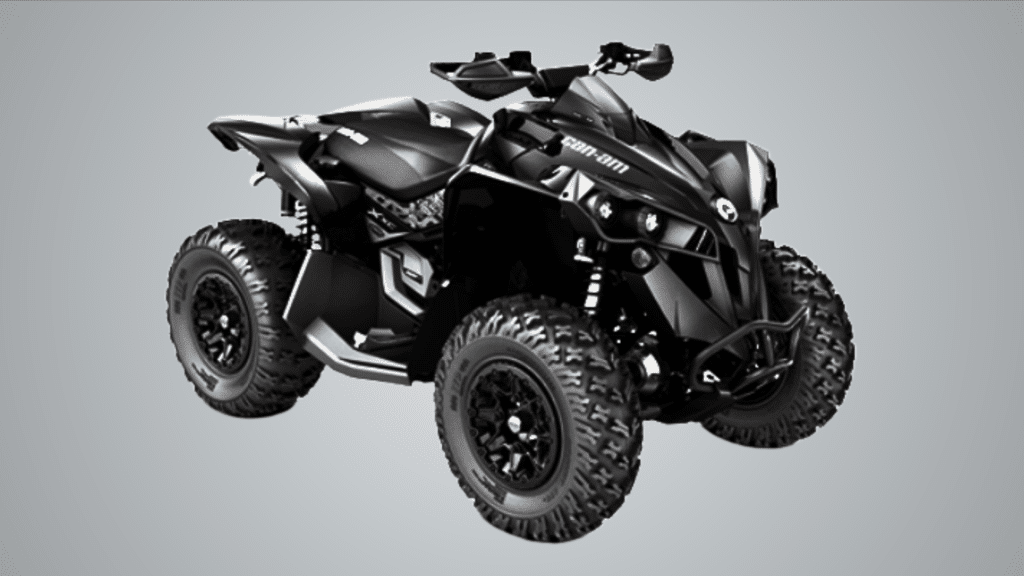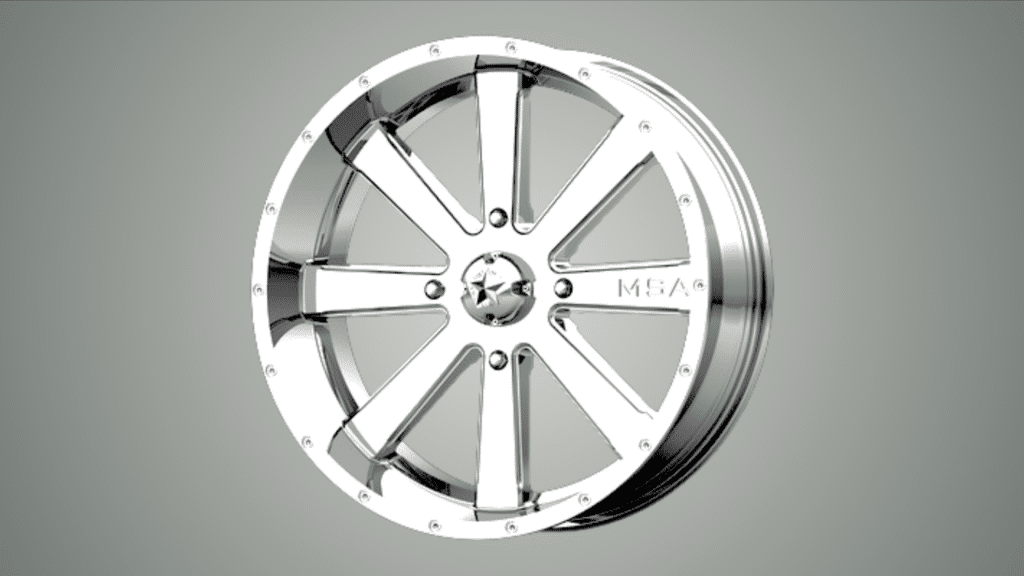The wheels on your vehicle connect through a specific pattern of bolts.
These bolts keep your wheels firmly in place as you drive.
The bolt pattern tells you how many bolts there are and how far apart they sit.
Let’s talk about the 4×156 bolt pattern. This means there are 4 bolts set 156 millimeters apart in a circle.
Many UTVs and ATVs use this pattern. Getting the right bolt pattern matters.
If you pick the wrong one, your new wheels won’t fit. Like puzzle pieces, they need to match perfectly.
Understanding 4×156 Bolt Pattern & its Measurements
When I look at a 4×156 bolt pattern, I break it down like this: The “4” shows how many bolt holes are on the wheel.
The “156” tells me these holes are 156 millimeters apart, measured from the center of one hole to another across the wheel.
I measure the bolt circle by finding the diameter between opposite holes.
For exact measurements, I use a bolt pattern gauge. This tool helps me get precise readings.
The spacing between holes must match perfectly. Even a small difference means the wheel won’t fit right.
Factors to consider when selecting wheels with a 4×156 bolt pattern
Wheel Material and Durability
I always check the wheel material first.
Steel wheels are tough and can take hard hits, but they add more weight to my vehicle.
When I want something lighter, I go for aluminum alloy wheels. They help me save fuel and improve handling.
I’ve learned that steel works better for rough terrain because it can handle impacts without cracking.
But for regular trail riding, I prefer alloy wheels. They look better and keep my vehicle nimble.
The material choice really affects how long my wheels last and how my vehicle moves.
Compatibility with Vehicle Model
I make sure to double-check my vehicle’s manual for the right bolt pattern.
Even if someone tells me 4×156 will fit, I verify it myself.
I’ve seen too many people waste money on the wrong wheels. I also look at the wheel offset and hub size.
These measurements are just as important as the bolt pattern. When I get it wrong, my wheels might rub against brake parts or not sit flush.
That’s why I always measure twice before buying.
Impact on Vehicle Performance
I pay attention to how wheel choices affect my ride.
Heavier wheels make my vehicle slower to speed up and stop. They also use more fuel.
But lighter wheels sometimes mean I feel more bumps in the road. The right bolt pattern keeps my wheels balanced.
When they’re balanced, my steering stays straight, and my tires wear evenly.
I’ve noticed that proper wheel fit makes my vehicle handle better on turns and keeps my ride smooth.
How to Install Wheels with a 4×156.3 Bolt Pattern
Tools Needed for Installation
- My torque wrench
- Floor jack
- Jack stands
- Lug wrench
- Socket set
- Wire brush (for cleaning bolt holes)
- Anti-seize compound
- Work gloves
- Safety glasses
- Wheel chocks
Steps for Installation
I start by parking on flat ground and using wheelchairs. After lifting my vehicle with the jack, I put jack stands under it for safety.
I remove old wheels one at a time and clean the hub surface and bolt holes with my wire brush.
I put anti-seize on the bolts before installing new wheels. I hand-tighten all bolts first, then use my torque wrench to get the right pressure.
I work in a star pattern to keep the pressure even.
Common Mistakes to Avoid During Installation
Incorrect Torque Settings
I’ve seen what happens when bolts aren’t tight enough. Wheels can come loose while driving.
But over-tightening is just as bad. It can stretch the bolts or crack the wheel.
I always follow the torque specs in my manual. I check the tightness after driving 50 miles, too.
This helps me catch any bolts that might have loosened up. Using the right torque keeps my wheels secure and prevents damage.
Not Checking Wheel Alignment
I never skip wheel alignment after installing new wheels.
Bad alignment leads to uneven tire wear and pulls my vehicle to one side. It wastes fuel, too.
I watch for signs like steering wheel vibration or the vehicle pulling left or right. If I notice these issues, I get my alignment checked right away.
This saves me money on tires and makes driving safer.
Applications of the 4×156 Bolt Pattern in Different Vehicles

Popular Models and Their Specifications
I see the 4×156 bolt pattern most often on Polaris vehicles.
From my experience, the RZR models, Sportsman series, and Scrambler ATVs all use this pattern.
These vehicles typically need strong wheel setups for rough terrain.
The Polaris General and Ranger series also use this pattern.
I’ve worked on many Can-Am models, too.
What stands out to me is how this pattern handles heavy loads and tough conditions.
It’s perfect for utility vehicles that carry cargo or pull trailers.
Performance and Aftermarket Upgrades
I find lots of wheel options for 4×156 patterns.
When I want to upgrade, I can choose from many brands like ITP, MSA, and Pro Armor.
This pattern lets me fit wider wheels for better grip.
I often tell people about the strength this pattern provides.
It handles bigger tires well, which is great for off-road use.
I can add beadlock wheels, too, which keep my tires in place during low-pressure off-road riding.
Benefits of the 4×156 Bolt Pattern
Enhanced Stability and Handling
I trust this bolt pattern because it spreads weight evenly across the wheel.
When I’m riding rough trails, the four-point design keeps my wheels steady.
It reduces wobble and makes my steering more precise.
I notice better control in turns because the bolts are well-spaced.
This spacing helps my wheels stay true even under hard cornering.
The 156mm measurement gives me good leverage against twisting forces, which means my wheels stay aligned better.
Wider Availability of Compatible Wheels
I love having many wheel choices. With the 4×156 pattern being common, I can shop around for the best deals.
If I need replacement wheels quickly, I usually find them in stock.
I’ve built good relationships with parts suppliers because they always have these wheels.
When I want to try different styles or sizes, I don’t feel limited.
This saves me time and money when maintaining my vehicle.
List of Vehicles Using 4×156 Bolt Pattern
| Brand | Model Series | Year Range | Vehicle Type |
|---|---|---|---|
| Polaris | RZR Series | 2008-2024 | UTV |
| Polaris | Sportsman Series | 2010-2024 | ATV |
| Polaris | General Series | 2016-2024 | UTV |
| Polaris | Ranger Series | 2009-2024 | UTV |
| Can-Am | Maverick Series | 2013-2024 | UTV |
| Can-Am | Commander Series | 2011-2024 | UTV |
| Arctic Cat | Wildcat Series | 2012-2024 | UTV |
| Honda | Pioneer Series | 2014-2024 | UTV |
Conclusion
The 4×156 bolt pattern plays a key role in my off-road experiences.
I’ve found that knowing these specifications makes wheel changes simple and safe.
Through this guide, I’ve shared my hands-on knowledge about materials, installation steps, and vehicle matches.
For anyone working with UTVs and ATVs, I want you to feel confident about wheel choices.
The right bolt pattern keeps you safe on trails.
With proper tools and steps, you can handle wheel changes at home.
Remember, correct torque and alignment matter most for your safety.


